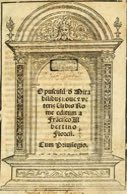_________________________________________________________________________________________
For more about me, click on the image

About eighty years before the collapse of Constantinople on the 29th May 1453, the family the Medici of Florence bought a large part of the ancient library. Towards the end of his life Cosimo conceives a personal ambition to read all the works of Plato. He commissions their translation into Latin by a Florentine scholar, Marsilio Ficino. In 1462 he establishes an informal Platonic Academy in Florence, with Ficino at its head. It was the re-birth of ancient knowledge (and translated) the so-called Renaissance.
Elderly scholars had to teach a new generation. And it was there that the 13 yrs old boy Michelangelo Buonarotti was discovered. Laurenzo dè Medici understood immediately the value of the kid, and took him under his wings. Michelangelo came to live in the house of the Medici, and was present at the table for supper to hear what other scholars had to discuss. He must have been happy.
Two years later, Christophle Colombus discovers America. We are talking 1492. It was not the best vintage year for the Church. On the throne of St.Peter came probably the pope with the worst reputation in the history: Alexander VI of the Borgia-family. With four legitimate children and over 30 illegitimate, they were giving scandal. The rumur was that his daughter Lucrezia was in her younger years almost a professional hooker and even slept with her father, the pope; Cesare Borgia, his son, the duke of Valentino was feared as a professional killer a.s.o.
Read more: History of the Medici
A reaction was provoked against this lifestyle of popes who acted like the worst emperors of the Roman Empire. Cardinal-hats were sold to the highest bidder, and it even seems that the papacy was for sale.
And the first outburst against those scandals happened in the city were the Renaissance was born: Florence. A fanatic monk stood up named Gerolamo Savonarola. He preached a world of conversion, away of the hedonic lifestyle, and summoned the people to rethink their roots. The revival of the ancient pagan world should be replace by a "City of God" like St. Augustine described in his Civitas Dei. God alone should be the king (and he, himself, maybe viceroy) Public penitence and processions were organized. People took their jewelry off and dressed themselves in black. This outburst led to the expulsion of the family dé Medici of Florence. When they left the city of Florence, together with them Michelangelo left and came to Rome.
The scandalous lifestyle of the Borgia's didn't prohibit Michelangelo to become in 1500, at the age of 23 yrs old, world famous. He made his Pietà for the St.Peter's Basilica. Being in Rome, he must have seen the Sistine Chapel, built 25 yrs prior, in 1475 by pope Sixtus IV. On the dimensions of the second temple of Jerusalem: 40 meters (43,74 yards) on 15 meter large (16,40 yards) and 20 meters high (21,87 yards). And because built in the renaissance time, it was build like the Roman Pantheon: one block of concrete, no iron or timber was used.
And it must have looked already fabulous: Pier Matteo d'Amelia painted a starry sky on the ceiling. and on the walls the frescoes of the most famous painters of the renaissance time from Toscany and Umbria. Between 1483-85 under the coordination of Perugino, they painted as a cartoon the life of Mozes and on the opposite wall the fulfilling of it in the life of Jesus.
I personally belief that the Sistine Chapel would have been today one of the most famous buildings in the world even without the later intervention of Michelangelo on the vault and the altar-wall.
Follow the link for a more detailed description of those works.
In 1503, the Borgia pope, Alexander VI, died and shortly after he was succeeded by Julius II, the warrior pope, the terrible pope, the nephew of Sixtus IV of the family Della Rovere. His model was not Julius Ist; his model was Julius Caesar. Benedict XVI is called the 16th, because he had 15 predecessors who took the same name. Julius II was not named after Julius Ist. His only model was Julius Caesar. It took him only a short while for starting his first war changing his ecclesiastical robes with something more suitable for the purpose: an armor and a good horse and a sword. And so he went on for the conquest of Bologna. And than Ferrara. Not being enough, he also added and extension to the middle and towards the south of Italy: the Pontifical State. Every nephew should get a piece of the cake; nephew in Italian is "nepote" and from there: "nepotism". Of course the pope needed for those wars the best army money could buy. And so it happened that in 1506, in January, the first regiment of Swiss arrived. Today they are still the eldest active regiment in the world. When you see them, their uniforms reflect the colors of the coat of arms of the family Della Rovere (the Oak-tree): Red, yellow and blue.



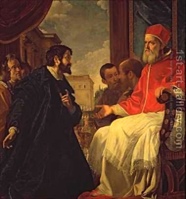
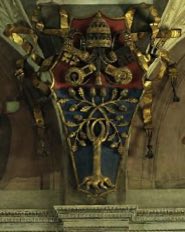
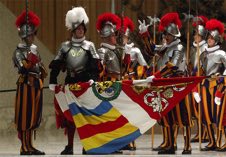
It was not long after he raised to the throne of Saint Peter that Julius II called Michelangelo in, as is described in the work of Vasari. The Pope had seen the Pietà and had heard of the David. Michelangelo was the best and would suit his megalomania in the best ways. He wanted a tomb for himself, and he had something great in mind. Here is starting the the Agony and Ecstasy of Michelangelo as is portrayed so well in the movie of 1965 with Charles Heston as Michelangelo and Rex Harrison as pope Julius II, after the script of Irving Stone of 1961.
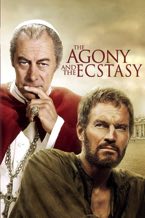
It was a time were Rome under Julius II became again the centre of the Arts and the World. Francesco Albertini made in those years a guidebook of Rome, Opusculu de Mirabilibus Nove et Veteris Urbis Rome, published in 1520. What Julius II achieved is such a short time, aside his wars, is really incredible. He was of course fortunate to have fantastic artists that surrounded himself: Bramante, Michelangelo and Raphael.
Michelangelo is the first know artist from which we have two biographies. Vasari wrote one when he was 75 years old, and his assistant Condivi wrote an other (with corrections) when Michelangelo was 78 years old.
Vasari described how Pope Julius II was just coronated and he called already Michelangelo. Being familiar with the Pietà, made only three years earlier, he was eager that Michelangelo would made his tomb.
And as you can read in the biography, the Pope saw it big, very big. An enormous amount of statues, and all incorporated in an architectonical structure to be build on top of the tomb of St. Peter in the Constantine Basilica. Here is starting the ecstasy of Michelangelo. You can imagine: for years to come, he had nothing else to do than what he loved the most: carving statues. I tried to feel his emotions: "Thank you, Your Holiness, thank you ..... but your Holiness, I believe there is a small problem; I think the old Saint Peter's Basilica is a little bit too small for your tomb ?!...." "No way", replied Julius II, "We are going to build a new one, and a much bigger one !", and Donato Bramante became in charge to start the project by demolishing the old Basilica.
Michelangelo went immediately to Carrara, the quarry, cut the blocks of marble and send some to Rome, others to Florence. Being there, he got a phone-call from Florence: "Hi Michelangelo, how are you doing?, Yes, here everything is fine ... yes indeed, we got rid of that stupid theocratic monk Savonarolla. Yeah, we've put him on the fire, at least back to normality... No, the family the Medici didn't come back yet, and all the surrounding powers looking at us like Goliath, and we are only a small David. We have here an 18 feet block of marble and nobody knows what to do with it. Can you finish your David that you started in 1501, and showing the world of our courage as underdog against the reigning powers that surrounds us? An so, we find Michelangelo in Florence making his David. Now he is for sure world-famous. While he is in Florence, Michelangelo in 1508 is 30 years old and receives the commission to paint one wall of the city hall.
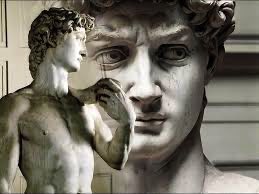
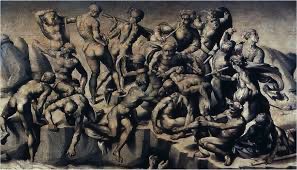
His rival, 51 years old, was the famous Leonardo da Vinci. When he saw the drawings of Michelangelo, he did everything in his power to get this prodigious rival out of Florence.
In Rome, the competition was not less fearful: Bramante, the appointed architect of the new St. Peter's Basilica, didn't want Michelangelo back. He knew that he would lose his job against Michelangelo in who he recognized his superior. And indeed, with time he will loose his job and was nicknamed "Ruinante", he only demolished the old basilica, but never built the new one. As a wheeler-dealer, Bramante went to Pope Julius II with the following: “saying that for a man to prepare himself a tomb during his own lifetime was an evil augury and a hurrying on of his death. And they persuaded his Holiness that on the return of Michelagnolo, he should cause him to paint in memory of his uncle Sixtus the vaulting of the chapel that he had built in the Palace. In this manner it seemed possible to Bramante and other rivals of Michelagnolo to draw him away from sculpture, in which they saw him to be perfect, and to plunge him into despair, they thinking that if they compelled him to paint, he would do work less worthy of praise, since he had no experience of colors in fresco, and that he would prove inferior to Raffaello, and, even if he did succeed in the work, in any case it would make him angry against the Pope; so that in either event they would achieve their object of getting rid of him. And so, when Michelagnolo returned to Rome, the Pope was not disposed at that time to finish his tomb, and requested him to paint the vaulting of the chapel.” And here is starting the Agony of Michelangelo. Forty years struggling against the pope, other popes and the heirs of Julius II for building the tomb. At the end he made only one statue: the Moses.
How he came to be a painter

Bartolomeo Veneto, Lucrezia Borgia

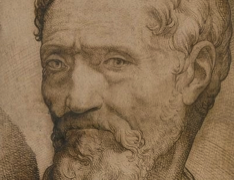

Convinced by the intriguing Bramante, Pope Julius II send a message to Michelangelo to return to Rome and to paint the Sistine Chapel. Michelangelo, who taught that painting was an inferior art, refused to come to Rome, saying that he was an architect, a sculptor and not a painter.
It is said that Pope Julius II was so furious about the refusal of Michelangelo, that he send a delegation to Florence, warning them, if they didn't send Michelangelo to Rome, he would feel obliged to invade Florence. And so, a few days later Michelangelo arrived in Rome to start his masterpiece in the Sistine Chapel, that would change the history of art.
Here on the left the sonnet that Michelangelo wrote towards the completion of the vault, where he complains that he couldn't move his neck anymore. But the last line is still the best, where he, after four and a halve years painting, exclaims: and I am NOT a painter !!!


